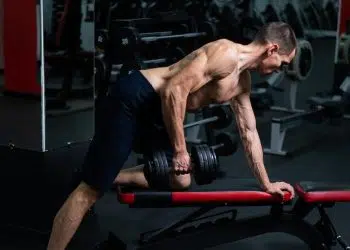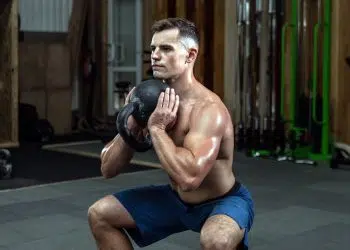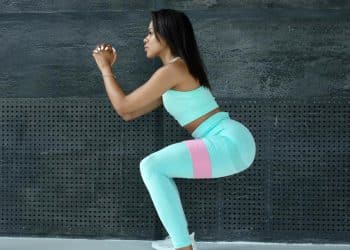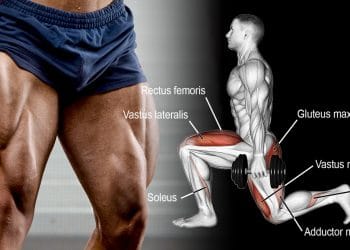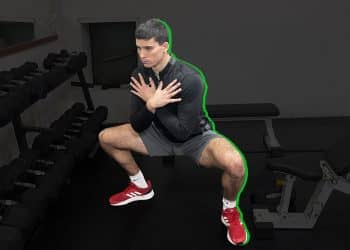There aren’t many exercises that are more productive than squats. Done correctly, squats can strengthen and build your entire lower body, and plenty of upper body muscles are involved, too.
As well as being an all-but essential training exercise, squats are also a movement pattern. In fact, it’s pretty hard to avoid doing at least a few squats every day!
There are lots of different types of squats to choose from, including front squats, back squats, Zercher squats, overhead squats, box squats, parallel squat and Smith machine squats. Each and every squat variation has benefits and drawbacks.
In this article, we’re going to compare goblet squats with sumo squats so you can choose the best one for your needs and goals.
Goblet Squat 101
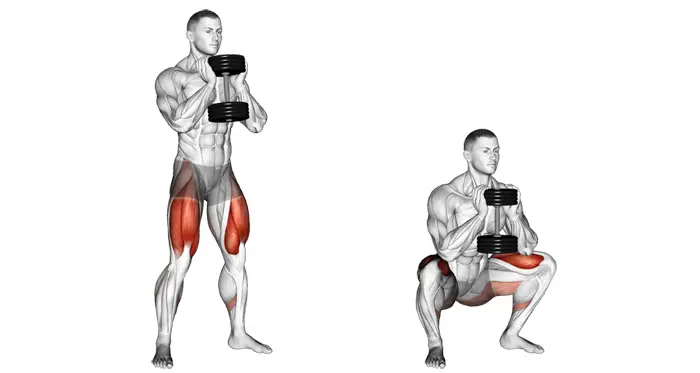
Most types of barbell squat are best done using a squat rack or power rack. That’s fine if you train in a well-equipped gym, but it could be a problem if you work out at home. Goblet squats are done without a squat rack, and you don’t even need a barbell. Instead, you do goblet squats with a single kettlebell or dumbbell.
Goblet squats are similar to front squats, but they’re much more forgiving and easier to perform. As such, goblet squats are popular with beginners and exercisers who cannot achieve or maintain the front squat rack position.
Level Up Your Fitness: Join our 💪 strong community in Fitness Volt Newsletter. Get daily inspiration, expert-backed workouts, nutrition tips, the latest in strength sports, and the support you need to reach your goals. Subscribe for free!
But goblet squats aren’t just for beginners; intermediate and advanced exercisers can do them too.
Muscles Worked
Goblet squats are a multi-joint compound movement that involves a long list of large and small muscles. The main muscles involved in goblet squats are:
- Quadriceps – front of the thigh
- Hamstrings – back of the thigh
- Gluteus maximus – back of hip
- Abductors and adductors – outer and inner thighs
- Erector spinae – lower back
- Biceps and triceps – front and back of the upper arms
- Core – midsection/abs
- Deltoids – shoulder muscles
- Trapezius – mid and upper back
- Rhomboids – mid back
How to do goblet squats
There are two ways to do goblet squats – with a kettlebell or a single dumbbell. Both options are equally effective.
Kettlebell goblet squat
- Hold your kettlebell by its vertical handles in front of your chest. The top of the handle should be just below your chin.
- Alternatively, turn the kettlebell upside down and hold it in the palms of your upturned hands. This is also the same grip you should use for the dumbbell version.
- Pull your shoulders down and back and brace your core.
- Stand with your feet between hip and shoulder-width apart, toes turned slightly outward.
- Keep your back slightly arched and squat down until your thighs are roughly parallel to the floor. Keep your knees in line with your feet. Do not round your lower back. Squat deeper if your flexibility allows.
- Stand back up and repeat.
Goblet Squat – Pros
Not sure if goblet squats are the best squat for you? Consider these benefits:
Easy to learn – goblet squats are relatively straightforward to learn compared to front squats and back squats. The rack position is comfortable and easy to maintain, and you can start with a light dumbbell or kettlebell instead of a standard barbell that weighs 45 pounds/20 kilograms.
Develops a good squat action – the position of the load makes goblet squats a good introduction to weighted squats. They promote an upright posture, encourage you to keep your knees out, and do all the other things that ensure your squat is as safe and effective as possible. Mastering goblet squats before progressing to barbell back and front squats should make learning those exercises considerably easier.
Minimal back stress – goblet squats are done with a very upright torso. This minimizes lower back strain. Other types of squat involve more forward lean, making them less low back-friendly.
Accessible – all you need to do goblet squats is a single kettlebell or dumbbell. With so little equipment required, most exercisers should be able to do goblet squats, even if they work out in a sparsely equipped home gym.
Safe – If you cannot complete a goblet squat rep, all you need to do is drop the weight on the floor in front of you. There is no such easy get-out with back squats, which is why it’s best to do them in a squat or power rack. Goblet squats are safe for solo exercisers and anyone who wants to train to failure.
A full-body workout – holding a kettlebell in front of your chest means that, as well as working your legs, goblet squats train your upper body too. When the weights start to get heavy, upper body strength (or a lack of it) will probably be the limiting factor when doing goblet squats.
Related: Full-Body Workout Plan
Goblet Squat – Cons
Goblet squats are an excellent exercise, but they’re not suitable for everyone. Consider these drawbacks before adding goblet squats to your workouts:
Not easy to get the weight into the starting position – initially, you’ll probably be able to curl your kettlebell or dumbbell into the correct starting position. However, that may not be possible if you progress to using heavier weights.
Instead, you’ll need to master a modified dumbbell/kettlebell power clean. If you “miss” your clean, the weight won’t be in the correct position, and you’ll need to try again.
You CAN start goblet squats with the weight resting on a bench, squatting down, and getting the weight into the correct rack position before standing up. While this is a good option for heavy weights, it’s still somewhat awkward.
Arm strength can be a limiting factor – you’ll need a strong upper body to do heavy goblet squats. With barbell front and back squats, the barbell rests on your shoulders.
That’s not the case with goblet squats. Instead, you need to support that weight with your arms. While this will give you a good biceps and triceps workout, your arm strength could also limit the amount of weight you can use for goblet squats.
Sumo Squat 101
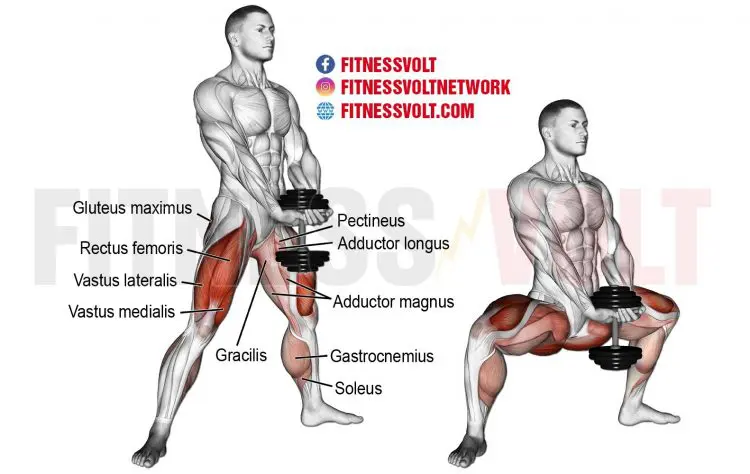
The wide stance or sumo squat is an exercise usually done to increase inner and outer hip and thigh engagement. It can be done “goblet squat style” but is more commonly performed using a barbell in the back-squat position.
Powerlifters use this squat variation to reduce their range of motion and lift more weight. General exercisers do it to get a more complete lower body workout. Sumo squats require and develop mobility and flexibility, especially around the hips.
Muscles Worked
Like goblet squats, sumo squats are a compound lower body exercise utilizing several joints and muscles at the same time. The primary muscles involved in sumo squats are:
- Quadriceps – front of the thigh
- Hamstrings – back of the thigh
- Gluteus maximus – back of hip
- Abductors and adductors – outer and inner thighs
- Erector spinae – lower back
- Core – midsection/abs
- Trapezius – mid and upper back
- Rhomboids – mid back
The wide stance means the glutes, abductors, and adductors are engaged more than they would be with a narrower stance.
How to do sumo squats
- Place a barbell in a squat rack so the bar is about shoulder-level. Grab the bar with a slightly wider than shoulder-width grip and duck under it. Press your upper back against the bar, so it sits on your traps and NOT your neck. Brace your abs and pull your shoulders down and back.
- Lift the bar off the supports and take 1-2 steps back. Move your feet out so that they are wider than shoulder-width apart. Turn your feet out slightly, so your toes and knees are pointing the same way.
- Pushing your feet and knees outward, push your hips back and squat down until your thighs are roughly parallel to the floor. Do not round your lower back. Keep your upper body tight and look straight ahead.
- Without bouncing, drive your feet into the floor and stand up straight. Keep pushing your knees outward. Reset your core and repeat.
- You’ll need to experiment to find the ideal foot placement for sumo squats. Start off with your feet slightly outside shoulder width and adjust from there. Move your feet in or out until you find the most comfortable, powerful position.
Sumo Squat – Pros
Undecided about sumo squats? Consider these benefits:
A balanced leg workout – all types of squats work your legs, but most tend to emphasize your quadriceps. The wide stance squat increases inner and outer thigh engagement and also gives your glutes a good workout (1). As such, they provide a more balanced leg workout than some other types of squats, especially those done with a fairly narrow stance, such as goblet squats.
Level Up Your Fitness: Join our 💪 strong community in Fitness Volt Newsletter. Get daily inspiration, expert-backed workouts, nutrition tips, the latest in strength sports, and the support you need to reach your goals. Subscribe for free!
Less low back stress – a wide stance means that many lifters can maintain a more upright torso with sumo squats, especially compared to back squats. This can help take stress off the lumbar spine.
Improved hip mobility and flexibility – adopting a wider stance for squats provides your lower body with a potentially beneficial stretch, especially for the muscles around the hips. If you want more mobile hips but don’t want to resort to more traditional stretching methods, sumo squats could help.
Increased joint stability – doing wide stance squats means pushing your knees outward, which increases hip stabilizer activity. Increased hip joint stability could help prevent hip AND knee injuries and improve athletic performance.
Less knee stress – a wider stance tends to allow your shins to remain more vertical during squats. This can help reduce knee stress. In contrast, goblet squats, front squats, and regular back squats often involve forward knee travel, putting more pressure on the knee joints. Wide stance squats are a helpful exercise for lifters with knee pain and may offer a more comfortable workout.
Easier to keep your heels down – if you’ve got tight calves and immobile ankles, you may find that your heels tend to lift when you do narrow stance squats. This can cause a weight shift that puts more stress on your knees and lower back and could reduce your squat performance. Sumo squats take tension off your calves and, with less forward knee travel anyway, you should have less trouble keeping your heels nailed to the floor.
Good transference to sumo deadlifts – if you want to increase your sumo deadlift performance, sumo squats could help. The movements are very similar, with the main difference being the position of the weight.
Sumo Squat – Cons
As beneficial as sumo squats are, they’re not without disadvantages, too. Consider these cons before adding them to your workouts:
Lack of hip mobility could limit squat depth – most lifters should try and descend until their thighs are parallel to the floor. You may also want to squat deeper, i.e., “ass to grass.” If you’ve got tight hips, you will probably find that you cannot sumo squat as deeply as you can with a more conventional stance.
Related: How Deep Should You Squat?
Hip pain – if you are unaccustomed to squatting with a wide stance, you could find that sumo squats hurt your hips. Avoid this problem by increasing the width of your stance gradually. Move your feet further apart as you get used to this exercise.
May feel unnatural – if you are used to doing conventional stance squats, sumo squats will feel unusual and could even be uncomfortable. This might put you off what is actually a very productive exercise. However, if you persevere, you’ll soon start to get used to doing squats with a wide stance, and they’ll begin to feel more normal.
Goblet Squat vs. Sumo Squat
So, now that you know a little more about goblet squats and sumo squats, let’s judge these two exercises by a few different criteria:
Goblet Squat vs. Sumo Squat: Strength
You can build strength with goblet and sumo squats. However, the weight you can use for goblet squats is limited by the strength of your arms. There is less of a restriction with sumo squats, especially if you do them using a barbell in a squat rack. So, if you want to lift heavy weights and get as strong as possible, barbell sumo squats are probably the best option.
Goblet Squat vs. Sumo Squat: Hypertrophy
Goblet and sumo squats are both effective hypertrophic or muscle-building exercises. But, because they involve different movements, they affect different muscles. Goblet squats are more knee-dominant, which means they emphasize your quads. Sumo squats are more hip-dominant, so they work your glutes, hamstrings, abductors, and adductors a little more. Choose the variation that targets the muscles you wish to develop.
Goblet Squat vs. Sumo Squat: Safety
Both goblet and sumo squats can be done safely. They allow you to maintain an upright torso, which means less stress for your lower back, especially compared to back squats. That said, sumo squats are best done using a squat rack, especially when training with heavy weights. In contrast, you can just drop the weight on the floor with goblet squats, so you are unlikely to get pinned under a heavy bar.
Goblet Squat vs. Sumo Squat: Ease of Learning
Of the two, goblet squats are usually easier to learn than sumo squats. Goblet squats use a standard-width stance, and the weight is easy to hold in place. Goblet squats are often used as a preparatory exercise before moving on to more advanced squat variations.
In contrast, sumo squats use a wide stance that is both challenging and unusual. Also, resting and holding a barbell on your back can be uncomfortable and tricky for novice lifters.
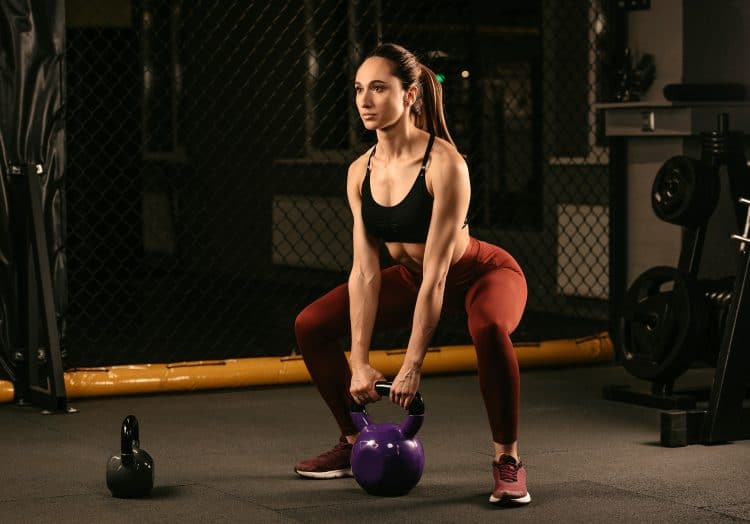
Goblet Squat vs. Sumo Squat: Equipment
All you need for goblet squats is a single dumbbell or kettlebell. Or, you can do them with a medicine ball held in your upturned hands. You don’t need a squat rack. However, to do barbell sumo squats safely, you need not just a barbell but a squat rack too. That said, you can also do sumo squats goblet-style, eliminating the need to use a squat rack.
Goblet Squat vs. Sumo Squat: Long-term Progression
The limiting factor for goblet squats is the amount of weight you can lift and hold. Eventually, you may find that you simply cannot hoist and support enough weight with your arms to challenge your legs.
In contrast, there are no such limitations with sumo squats using a barbell and squat rack. You should be able to continue adding weight for much longer, making them better for long-term progression.
Goblet Squat vs. Sumo Squat: Variety
One of the best ways to avoid progress plateaus is to change your workout from time to time and use variations of your main exercises. In many cases, simply altering the width of your stance or the angle of your bench is all that’s needed to avoid training ruts.
Good goblet squat variations include:
- Box goblet squats – briefly touch a box with your butt at the bottom of each rep
- Paused goblet squats – pause at the bottom of each rep for 2-5 seconds
- Goblet squats with bands – to increase load as you approach lockout
- Speed goblet squats – use 50% of your 1RM and lift the bar as fast as you can
- Goblet squat jumps – to increase explosive power
Sumo squats can also be done in several different ways:
- Box sumo squats – briefly touch a box with your butt at the bottom of each rep
- Paused sumo squats – pause at the bottom of each rep for 2-5 seconds
- Sumo squats with chains or bands – to increase load as you approach lockout
- Speed sumo squats – use 50% of your 1RM and lift the bar as fast as you can
- Anderson squats – start each rep with the bar resting on low pins in a power rack
- Goblet sumo squats – use a dumbbell or kettlebell instead of the more usual barbell
With plenty of variations available for both exercises, there is no reason to do the same type of goblet or sumo squat over and over again. Use these variations to keep your workouts productive.
Goblet vs. Sumo Squat – Wrapping Up
Whatever you are training for, squats will help you get there faster. You can use squats to build muscle mass, get stronger, improve your sports performance, or even burn fat and get lean. It all depends on how you program these exercises.
That said, there is more to this exercise than conventional back squats and front squats. As good as they undoubtedly are, you’ll soon get bored of them if that’s all you ever do. You may also find that they aren’t exactly right for your training needs.
The good news is there are lots of additional squatting variations you can use to reach your fitness goals. And now, you can add goblet and sumo squats to that list.
Which one is better? That depends on you.
For some, goblet squats are the way to go, but for others, it’s sumo squats that are best. Choose the one that matches your workout requirements or, if you cannot pick one, why not do them both? After all, goblet squats and sumo squats are two very effective exercises.
References:
1. PubMed: Stance Width and Bar Load Effects on Leg Muscle Activity During the Parallel Squat (Pubmed)
Interested in measuring your progress? Check out our strength standards for Overhead Squat, Zercher Squat, Smith Machine Squat, and more.


